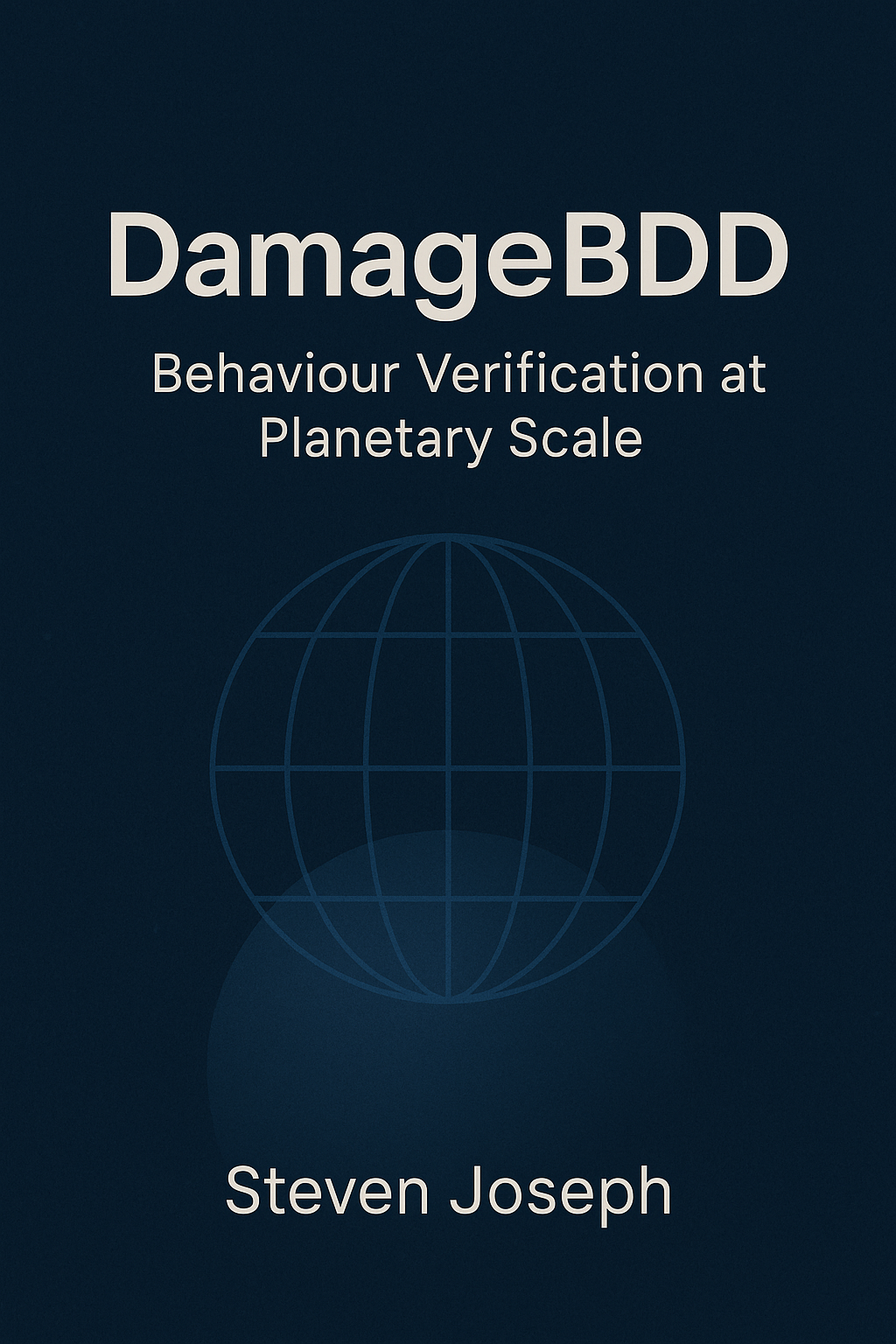DamageBDD – Verifying Software Behaviour at Planetary Scale
DamageBDD: Behaviour Verification at Planetary Scale
A beginner-to-advanced guide from BDD → Behaviour-Driven DevOps → the Verification Economy.

What is DamageBDD?
DamageBDD is a platform that lets anyone – not just programmers – describe how software should behave, using simple sentences. These sentences are written in a format called BDD (Behaviour Driven Development), which turns software testing into a conversation instead of a cryptic task only engineers understand.
Think of it like writing instructions for how an app should work, and DamageBDD automatically checks if the app really does that. This makes it possible for teams of all skill levels – developers, testers, support staff, even end users – to work together and catch problems before they reach the real world.
Why is it powerful?
Unlike traditional testing tools that need experts and manual effort, DamageBDD:
- Uses plain language to define tests
- Works across technical and non-technical teams
- Can simulate massive user activity to test performance
- Works automatically inside CI/CD (Continuous Integration/Deployment) systems
- Can detect performance issues before they go live
- Enables Bitcoin-based payments for verified contributions
This means DamageBDD isn’t just about testing – it’s about trust, transparency, and automation at scale.
Example
Feature: Test echo json functionality of JsonTest.com using HTTP API
Scenario: GET request to JsonTest.com
Given I am using server "http://echo.jsontest.com"
When I make a GET request to "/key/value/one/two"
Then the json at path "$.one" must be "one"
This tells DamageBDD what to test – and it does the heavy lifting behind the scenes, checking servers, APIs, and even entire apps.
Business Use Cases
- Web & Mobile Apps: Monitor uptime, load, and functionality
- Smart Contracts (Web3): Continuously audit decentralized apps
- Enterprise Systems: Automate QA and compliance checks
- Infrastructure Teams: Track service availability and performance
- Product Teams: Capture feature requests and real-world usage
- AI & Bots: Autogenerate tests and verify their own behavior
Revenue Streams
- 🟠 Pay-per-Test: Users pay in Bitcoin or DAMAGE tokens to run tests at scale
- 🟢 Bug Bounties: Token rewards for contributors who define useful tests
- 🔵 DeFi Integration: Smart contracts trigger payments only when conditions are verified
- 🟡 Verification-as-a-Service: Enterprises pay for automated third-party verification
- 🟣 Token-Governed Test Market: A decentralized ecosystem where testers and developers collaborate, get paid, and build trust
Target User Roles
| Role | Use Case |
|---|---|
| End User | initial requirements, feature requests, defect reporting |
| Product Support | feature requests, isolating defect behaviour, edge cases, monitoring, alerting |
| QA | define expected behaviours, continuous monitoring, reporting, alerts |
| Infra | availability monitoring, endpoint latency reporting, alerts |
| Development | prototyping, maintenance, verification, continous monitoring |
| Management | project velocity, current progress, performance metrics, fund allocation |
Feature Highlights
| DamageBDD Feature | Status |
|---|---|
| REST API for test execution | ✅ Done |
| Scheduled testing, continuous testing config | 🧪 Testing |
| Bitcoin & DeFi payment system | 🔨 In progress |
| Secrets management and variable templates | 🧪 Testing |
| CI/CD integration and monitoring | 🧪 Testing |
| AI-generated tests and code suggestions | 🧠 In analysis |
| Appium and Selenium browser/mobile testing | 🧪 Testing |
| IPFS reports, dashboards, alerts | 🧪 Testing |
| Webhook triggers | 🧪 Testing |
| Zero Knowledge Proof test validation & payouts | 🔍 Researching |
| DAMAGE Token governance and test ecosystem incentives | 🪙 In analysis |
Why DamageBDD is Unique
- 🧠 Human-readable testing
- 🚀 Planetary-scale automation
- ⚡ Bitcoin-native monetization
- 🕵️ Verifiable trust in every test
- 🤝 Open contribution and collaboration
Links
- 📄 DAMAGE Token Whitepaper The official guide to the DAMAGE Token vision, design, and use cases.
- 📄 DamageBDD Book The official book to the DAMAGE Token vision, design, and use cases.
- 📊 Explore Token Stats Track live data on DAMAGE token supply, holders, and transactions.
- 👛 Wallets Find supported wallets for storing and managing your DAMAGE tokens safely.
- 💬 Telegram Join the community chat for real-time discussions and support.
- 🎮 Discord Connect with developers and contributors in our Discord server.
- 🧭 Nostr Follow DamageBDD on Nostr for decentralized updates.
- 🔒 Security Guidelines Learn best practices to keep your accounts, tokens, and nodes secure.
- 💻 GitHub Repository Explore the open-source code powering DamageBDD.
- 🔗 LinkedIn Page Follow our LinkedIn for project news, thought leadership, and hiring.
- 📑 API Docs Developer documentation for integrating with DamageBDD APIs.
- 💱 DAMAGE/USDT on Coinstore Trade DAMAGE tokens directly on the Coinstore exchange.
- 🎥 Video: Better Smart Contracts with BDD A short video introduction to BDD for smart contract design.
- 📝 Smart Contract BDD Article Read an in-depth article on using BDD for smarter contracts.
- 🛠 DamageBDD Tasks on Microlancer Take on bounties and earn rewards by contributing to DamageBDD.
- 💻 Run a Damage Node Participate in the Damage network, spend and earn DAMAGE with you computer.
